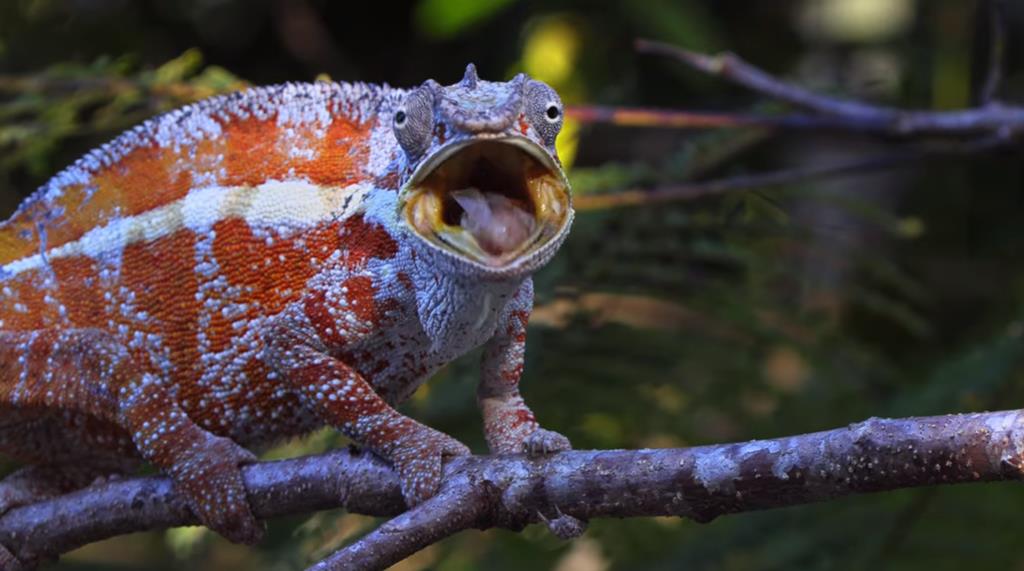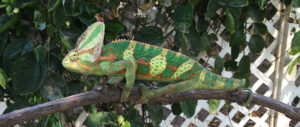Your chameleon cage should contain climbing branches, foliage for hiding, a basking lamp, and a water source. Ensure proper temperature gradients and UVB lighting are also set up.
Setting up the perfect habitat for a chameleon involves more than just an enclosure; it’s about recreating a slice of their natural environment. These arboreal reptiles thrive when given ample vertical space to climb and explore. Branches of various thicknesses mimic their natural climbing terrain, promoting physical activity and good health.
Foliage, live or artificial, offers essential hiding places that provide security and stress relief for your chameleon. A consistent water source, like a dripping system, encourages hydration through their instinctive drinking habits. The right heating and lighting equipment, including a UVB source, enable proper digestion and nutrient synthesis. By focusing on these elements, you offer your chameleon a sanctuary that not only meets their basic needs but also supports their overall well-being.
Creating The Perfect Habitat
Creating the Perfect Habitat for your chameleon involves more than just aesthetics. It’s about replicating their natural environment to promote health and well-being. That requires attention to cage size, climate, and more. Follow these guidelines to craft a home where your chameleon can thrive.
Choosing The Right Cage Size
An ample cage is crucial for your chameleon’s welfare. A small cage can cause stress and health issues. Here’s what to consider:
- Height: Chameleons love to climb. Aim for a cage that is at least 3 feet tall.
- Space: Ensure the cage provides enough room to move. A 2x2x3 feet cage is suitable for a single adult chameleon.
- Growth: Buy a cage to accommodate growth. Bigger is better.
Essential Climate Control
Chameleons need specific conditions to stay healthy. Use these tips for climate control:
| Feature | Requirement |
|---|---|
| Temperature | A range between 72-80°F during the day, with a drop to 65-70°F at night. |
| Humidity | Levels around 50-70%. Mist the cage twice daily or use a humidifier. |
| Lighting | UVB lighting is essential for vitamin D3 synthesis, 12 hours per day. |
Use thermometers and hygrometers to monitor conditions. Keep environments stable for your pet’s comfort.
Lighting And Temperature Needs
Creating the perfect home for your chameleon starts with understanding their lighting and temperature needs. Both elements mimic their natural habitat and play crucial roles in their overall health. Let’s dive into how to set up the ideal environment focusing on lighting and temperature within your chameleon’s cage.
Uvb Lighting For Health
A chameleon’s health is closely tied to proper UVB lighting. UVB light is a type of ultraviolet light that is vital for chameleons to synthesize vitamin D3. This process allows them to absorb calcium effectively, keeping their bones strong and preventing metabolic disorders.
- Install a UVB bulb that spans two-thirds of the cage.
- 12-hour light cycle simulates their natural environment.
- Change the bulb every 6-12 months to ensure consistent UVB levels.
Maintaining Ideal Temperatures
Chameleons are cold-blooded and need a range of temperatures to regulate their body heat.
| Area of Cage | Temperature |
|---|---|
| Basking Spot | 85-95°F (29-35°C) |
| Ambient Temperature | 70-80°F (21-27°C) |
| Night Temperature | 65-70°F (18-21°C) |
- Use thermostats and thermometers to monitor conditions.
- Provide a temperature gradient by placing heat sources strategically.
- Ensure nighttime cooling for optimal health.
Setting Up The Interior
Setting up the interior of your chameleon cage is vital for its health and happiness. A well-assembled habitat mimics their natural environment. It encourages normal behaviors. Think variety and safety in everything from perches to plants.
Safe Plants And Branches
Chameleons love to climb! Sturdy branches are crucial. They need different thicknesses and angles. This helps your chameleon exercise and explore. Always choose non-toxic plants. Safe options include:
- Ficus
- Hibiscus
- Pothos
Ensure plants and branches are secure. Chameleons rely on these structures for support.
Substrate Selection For Your Chameleon
The right substrate keeps humidity levels steady. It also aids in waste management. Popular choices include:
| Substrate Type | Benefits |
|---|---|
| Reptile carpet | Easy to clean, reduces risk of ingestion |
| Coconut fiber | Retains moisture, encourages natural digging behavior |
Avoid loose substrates like sand or small pebbles. These can cause impaction if eaten. Always choose the safest option for your pet’s size and species.
Hydration And Humidity
Chameleons are not your average pets, especially when it comes to their habitat’s hydration and humidity needs. In the wild, they thrive in moist environments, and your cage setup should mimic this to keep your reptilian friend healthy and happy. It’s more than just providing water; it’s about creating an ecosystem that sustains the proper moisture levels for your chameleon’s well-being.
Water Drip Systems
Water drip systems emulate the natural way chameleons drink in the wild. Chameleons prefer sipping water off leaves rather than drinking from a water bowl. A simple yet effective setup involves:
- A drip container positioned above the foliage
- Adjustable valve to control water flow
- Placement ensuring drips land on leaves where chameleons can drink
Misting And Monitoring Humidity
Misting is crucial for keeping the humidity within the right range, usually between 50% to 70%. Automate this process with:
- Automatic misting system to periodically spray fine mist
- Manual spray bottle for hands-on control
Consistently monitor humidity levels with a hygrometer. You want to ensure your cage environment resembles a chameleon’s natural habitat. Aim for:
| Time of Day | Humidity Level |
|---|---|
| Daytime | 50% |
| Nighttime | 70% |
Twice-daily misting works well to maintain the cage’s humidity. Always use clean, dechlorinated water for your chameleon’s health.
Feeding Essentials
Chameleon care starts with a proper diet. For these colorful critters, mealtime is an adventure—a blend of hunting and nutrition. In their cages, we simulate this unique experience. But how? Let’s explore the essentials for feeding your scaly friend.
Food Dish Vs. Free-range Feeding
Choosing the right feeding strategy is critical. Think about your chameleon’s needs and your daily routine.
- Food Dish: Easy monitoring of food intake. Perfect for tidy owners. Reduces overfeeding risks.
- Free-Range Feeding: Mimics natural hunting behaviors. Encourages exercise and mental stimulation. May require more cleanup.
Supplements For A Nutritious Diet
Supplements are non-negotiable for chameleon health. They prevent bone disease and other issues.
| Supplement Type | Frequency |
|---|---|
| Calcium without D3 | At almost every feeding |
| Calcium with D3 | Twice a month |
| Multivitamins | Every two weeks |
Dust these supplements on insects before offering to your chameleon. Ensure thorough coverage for optimal health benefits.
Regular Maintenance
Welcome to the crucial aspect of Regular Maintenance for your chameleon cage. A pristine environment is not only pleasing to the eye but paramount for the well-being of your color-changing companion. Grasp the essentials of keeping the habitat in top-notch condition with these guided steps.
Cleaning Routines
Consistency is key when it comes to cleaning routines. A clean cage prevents diseases and maintains a healthy habitat. Start by establishing a weekly cleaning schedule that includes:
- Removing waste and uneaten food daily.
- Sanitizing water dishes and misting systems weekly.
- Washing and disinfecting foliage and decor.
Every month, a deep clean is essential. This involves:
- Taking everything out of the cage.
- Cleaning the surfaces with reptile-safe disinfectants.
- Rinsing thoroughly to remove any cleaning residue.
Ensure the cage dries completely before your chameleon re-enters its home.
Monitoring Chameleon Health
Observing your pet’s health is part of regular maintenance. During cleaning, scrutinize your chameleon for any signs of stress or illness. Check for:
| Health Indicator | What to Look For |
|---|---|
| Activity Level | Is it active or lethargic? |
| Eating Habits | Any changes in appetite? |
| Skin Condition | Shedding normally? Any sores? |
| Eye Health | Clear and fully open eyes? |
Track the temperature and humidity daily with reliable gauges. Use fresh water for misting and ensure the lighting cycle replicates natural sunlight.
Frequently Asked Questions On What Should I Put In My Chameleon Cage?
What Essentials Do Chameleon Cages Need?
Chameleon cages require proper ventilation, sufficient space, and a variety of horizontal and vertical climbing branches. It’s essential to include foliage for hiding and a UVB light for health. A dripping system or misting for hydration is also crucial. Temperatures should have a gradient.
How To Maintain Humidity In Chameleon Habitats?
To maintain humidity in a chameleon cage, use a mister or humidifier. Live plants also help. Monitor the humidity with a hygrometer to ensure it stays within the recommended range, typically between 50-70% for most species. Mist the cage twice daily to maintain proper hydration.
Can I Use Artificial Plants In My Chameleon’s Cage?
Yes, you can use artificial plants in a chameleon cage. They provide climbing and hiding places without needing the care live plants do. However, mixing in live plants can enhance the humidity and provide a more natural environment. Ensure that artificial plants are non-toxic and safe.
What Lighting Does My Chameleon Require?
Chameleons need UVB lighting to synthesize vitamin D3, essential for calcium absorption. Use a linear UVB bulb running the length of the cage to ensure adequate exposure. Replace the bulb every 6-12 months, as UVB output diminishes over time, even if the light remains bright.
Conclusion
Creating the perfect environment for your chameleon is key to its health and happiness. Remember, a balanced mix of plants, branches, and appropriate substrate makes all the difference. Tailor your chameleon’s enclosure to its unique needs, and you’ll ensure a thriving habitat for your vibrant friend.
Keep researching, stay creative, and watch your chameleon flourish in its well-appointed home.

